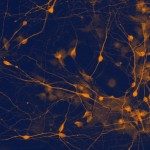Lien vers Pubmed [PMID] – 22061967
Mol. Cell. Neurosci. 2012 Feb;49(2):97-103
In rodents and most other mammals studied, neuronal precursors generated in the subventricular zone (SVZ) migrate to the adult olfactory bulb (OB) to differentiate into interneurons called granule and periglomerular cells. How the newborn cells navigate in the postnatal forebrain to reach precisely their target area is largely unknown. However, it is often thought that postnatal neurogenesis recapitulates the neuronal development occurring during embryogenesis. During brain development, intracellular kinases are key elements for controlling cell polarization as well as the coupling between polarization and cellular movement. We show here that the polarity kinase MARK2 maintains its expression in the postnatal SVZ-OB system. We therefore investigated the potential role of this kinase in adjusting postnatal neuroblast migration. We employed mouse brain slices maintained in culture, in combination with lentiviral vector injections designed to label neuronal precursors with GFP and to diminish the expression of MARK2. Time-lapse video microscopy was used to monitor neuroblast migration in the postnatal forebrain from SVZ precursors to cells populating the OB. We found that reduced MARK2 expression resulted in altered migratory patterns and stalled neuroblasts in the rostral migratory stream (RMS). In agreement with the observed migratory defects, we report a diminution of the proportion of cells reaching the OB layers. Our study reveals the involvement of MARK2 in the maintenance of the migratory direction in postnatally-generated neuroblasts and consequently on the control of the number of newly-generated neurons reaching and integrating the appropriate target circuits.

